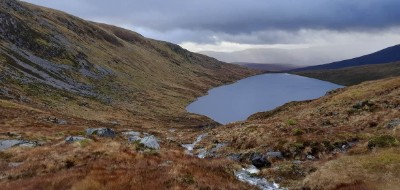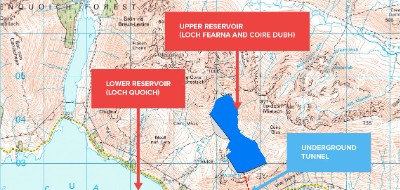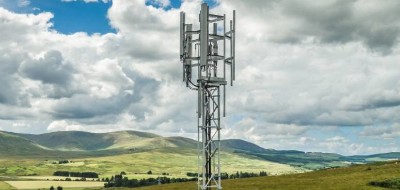Wednesday 17th April 2024, 12:00pm
National Planning Framework 4, which came into effect in February 2023, has made it easier for certain types of development proposed for Wild Land Areas to get permission through the planning system. Access & Conservation Officer, Davie Black, takes a look at the ones which are currently giving cause for concern...
Earba Pumped Storage Hydro

A large civil engineering project in a wild land area, lying in the hills between Loch Laggan and Loch Pattack. The proposed upper reservoir is a massive expansion of a natural loch at altitude. This is more than attrition of wild qualities around the edge of the wild land boundaries, the construction and landscaping will be deep into the heart of the area. The need for high-capacity hydro to balance the vagaries of onshore wind is without question, but it is difficult to say not here, because where else would it be built? Our response to it can be read here.
Image: Gilkes Energy Ltd
Fearna Pumped Storage Hydro

Another pumped storage hydro scheme at an early scoping stage, expanding a natural loch in a Wild Land Area by Loch Quoich. Again, the storage capacity is needed to buffer erratic electricity generation from wind power, but here it is close to a major transmission powerline upgrade, and with clusters of windfarms creeping closer to the east of it. Would this one be of better use in wild land, rather than Earba?
The Scottish Government are letting us all down by not producing a national strategy for large-scale hydro, as it is essential infrastructure – how much capacity is required? Where are the potential locations suitable for it? We could then debate and agree (or not) and accept it, rather than this endless, ongoing, attritional process.
Image: Gilkes Energy Ltd
Shared Rural Network 4G telecoms masts

Most hill-goers are now aware of this rash of development proposals in remote areas, serving no local residences or businesses. The commercially unviable Total Not-Spots rolled out through millions of public funding. We continue to oppose masts that are proposed for wild places that have mountaineering interest and no local community requirements.
Wouldn’t it be more sensible to allocate the diminishing public funding to where they are actually needed by rural communities?
If you are concerned by this lend your voice to the protest – you can find out what’s live by joining the Shared Rural Network Mast Action Group Facebook page.
Windfarms

Developers have been heartened by what NPF4 offers them, and wild land is gouged away at the edges by turbines, haul roads and grid connection powerlines. More on this coming soon!
If there's an issue relating to access, conservation, planning or similar that you'd like to bring to our attention, please contact send an email to access@mountaineering.scot